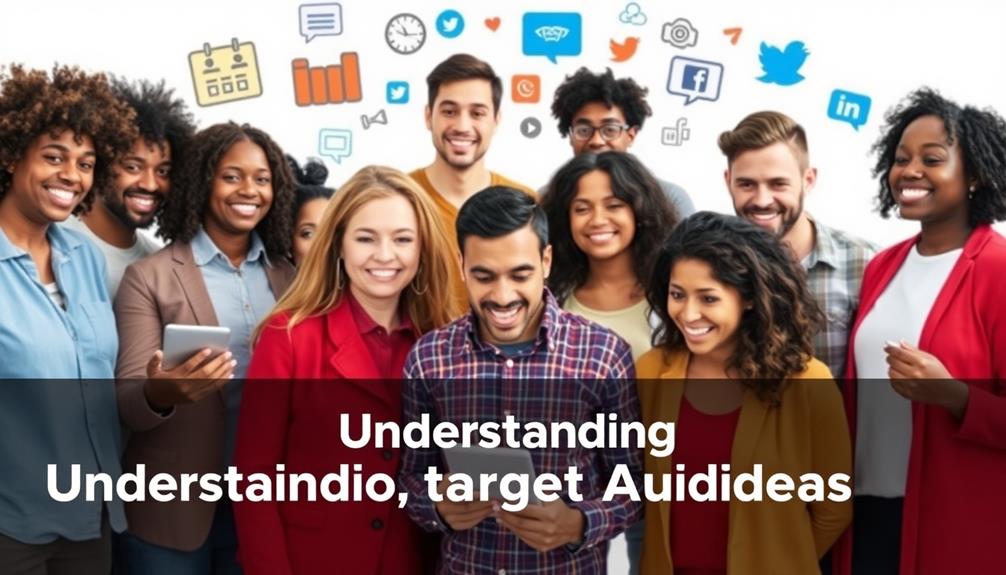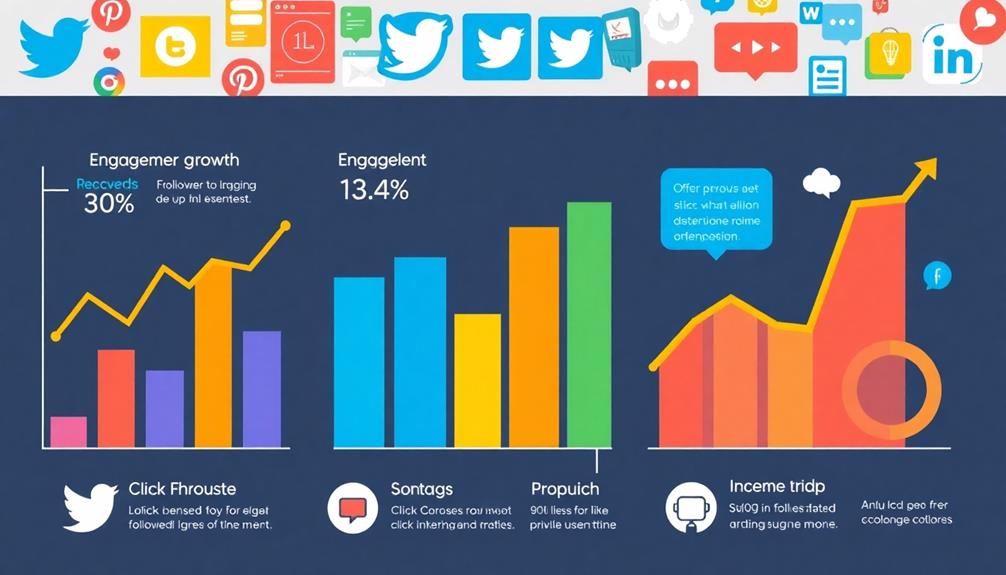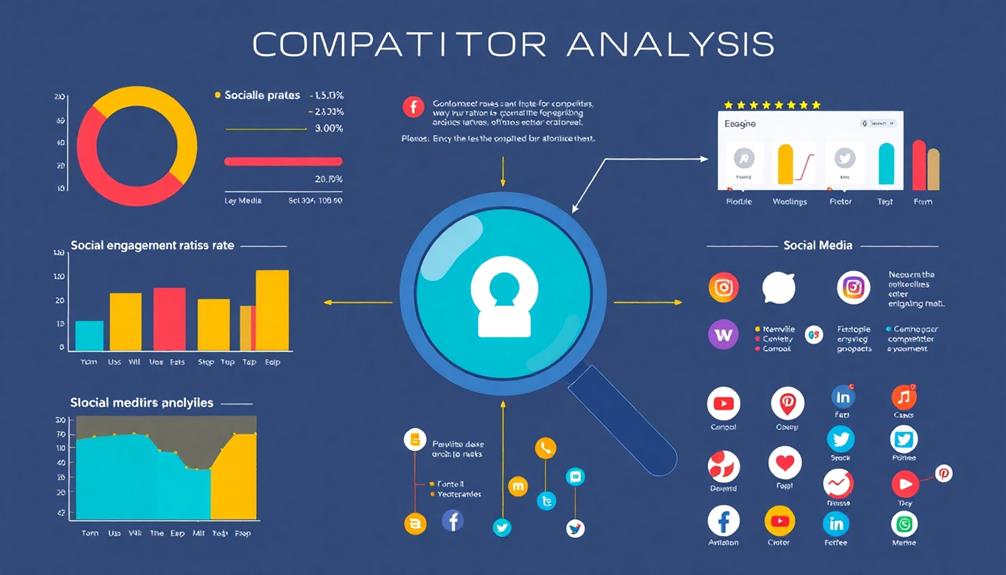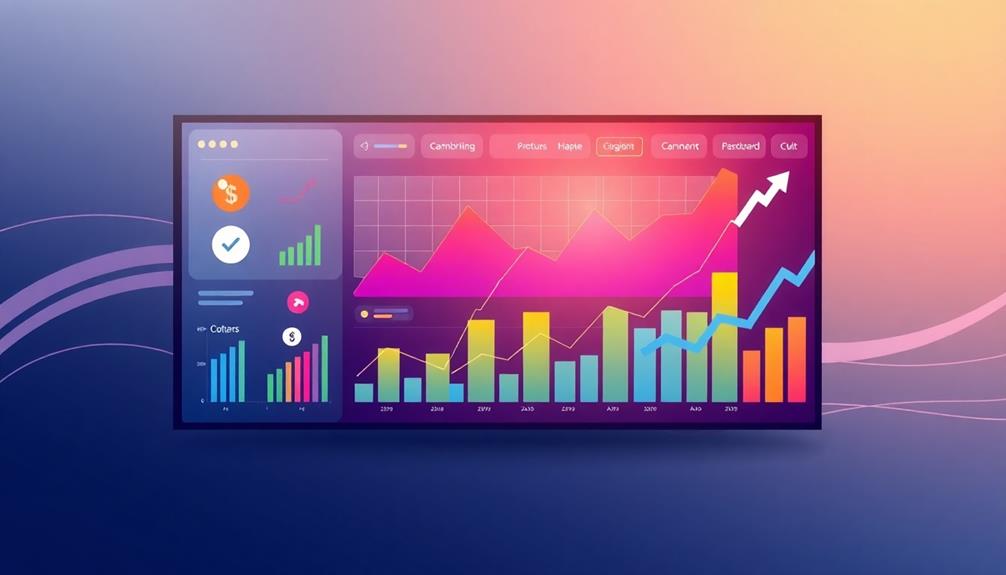Business
The Best Ways to Promote Your Blog Content
Learn the most effective strategies to promote your blog content and discover how small changes can lead to significant growth. What will you implement first?

To promote your blog content effectively, focus on guest posting and creating unique, data-driven pieces. Engage actively with your audience in comments and social media, fostering community and loyalty. Updating old posts can boost your traffic considerably, while transforming content into infographics or videos expands your reach. Don't overlook email marketing—building a subscriber list enhances direct communication. Finally, use high-quality visuals on social media to increase engagement. These strategies can elevate your blog's visibility and attract more readers. Curious to discover more tips to amplify your content's reach? Keep exploring what works best for you!
Key Takeaways
- Engage in guest posting on niche blogs to expand your reach and tap into new audiences.
- Leverage social media by sharing visually appealing content and interactive posts to boost engagement.
- Utilize email marketing with targeted campaigns to foster direct communication and increase readership.
- Update and repurpose existing content to enhance its relevance and improve search engine rankings.
- Collaborate with fellow bloggers for mutual growth and to create compelling case studies showcasing success.
Effective Guest Posting Strategies

When it comes to boosting your blog's visibility, effective guest posting strategies can make a significant impact. By reaching out to relevant blogs in your niche, you can promote your content and establish authority.
Conducting thorough keyword analysis can help you identify topics that resonate with your target audience, further enhancing the value of your guest posts. Start by crafting a compelling outreach email that highlights your unique content and how it can benefit their audience. This not only boosts blog traffic but also opens the door for valuable backlinks that enhance your SEO performance.
Collaborating with bloggers at a similar level can lead to mutual growth. Regular discussions can yield shared tips and tactics for effective promotions, creating a supportive network.
Make sure to engage with the audience through thoughtful comments on your guest posts; this fosters community interaction and encourages readers to visit your main blog.
Creating Unique, Data-Driven Content

Creating unique, data-driven content not only boosts your blog's visibility but also establishes you as a credible authority in your niche. By focusing on data-driven content, you can notably increase organic traffic, as well-researched posts often attract thousands of social shares.
For instance, incorporating insights on the nutritional advantages of green juice can engage health-conscious readers. While conducting your own studies can be resource-intensive, even simpler data interpretations can yield high reader engagement.
Start by identifying content gaps in your competitors' offerings. Create in-depth, unique guides on less-covered topics to differentiate your blog. Collaborate with your readers to showcase their success stories in detailed case studies. This approach not only enhances your credibility but also draws in more audience interest.
Incorporating engaging infographics and visualizations transforms complex information into easily digestible content. This boosts shareability while keeping your readers engaged.
When you present data in an appealing format, you improve retention and encourage your audience to share your insights. By consistently producing unique, data-driven content, you position yourself as a thought leader and guarantee your blog stands out in a crowded space.
Updating and Repurposing Existing Posts

Updating your old blog posts can greatly boost your traffic, often by over 25%.
By transforming content into different formats, like videos or infographics, you not only refresh its relevance but also reach a broader audience.
Incorporating trending topics, such as exotic fruit blend inspirations, can further enhance engagement and interest.
Keeping your posts current guarantees they remain valuable and shareable, driving even more visitors to your site.
Boosting Traffic Through Updates
Revamping your old blog posts can be a game-changer for your site's traffic and visibility. By updating old blog posts, you not only boost traffic but also improve search engine optimization (SEO).
Daily goal tracking can enhance your content strategy, ensuring that you remain consistent and focused on your objectives. Search engines favor fresh content, so regular content refreshes can improve visibility and attract organic traffic.
In fact, studies show that simply updating existing posts can lead to an average traffic increase of 25.71%. Imagine the impact of additional visitors—one case study revealed a staggering 410,322 yearly visitors after content refreshes!
To make your posts more shareable and relevant, incorporate new data, insights, or perspectives that resonate with current trends. Repurposing blog posts into engaging formats can also widen your reach, saving time and effort while connecting with new audiences.
Whether it's turning a post into a video or an infographic, you've got options to keep your content fresh and dynamic. Ultimately, these strategies not only enhance your blog promotion efforts but also create valuable, shareable content that can greatly boost your online presence.
Transforming Content Formats
Transforming your existing blog posts into different content formats can breathe new life into your overall strategy. By repurposing content, you can greatly boost traffic, enhance engagement, and improve your SEO performance. Revamping older posts with updated information helps them rank higher in search results, while transforming them into visual content like infographics or videos can attract new audiences.
Here's a table to help visualize your content transformation options:
| Format | Purpose | Benefits |
|---|---|---|
| YouTube Video | Provide a new perspective | Saves production time, attracts high views |
| Infographic | Enhance information delivery | Increases engagement, shares easily |
| Social Media Snippet | Drive traffic back to blog | Encourages sharing, boosts visibility |
Using these content marketing techniques, you'll not only revitalize your posts but also create multiple engagement points. Visual content is shared three times more than text-based posts, so don't hesitate to get creative. By transforming content formats, you're actively promoting your blog content and ensuring it reaches a wider audience.
Enhancing Relevance Over Time
Keeping your blog content fresh and relevant is essential for maintaining audience interest and driving traffic. One effective way to promote your blog is by updating existing content. Studies show that revitalizing your posts can lead to a traffic boost of about 25.71%. By strategically updating your articles, you could potentially attract an additional 410,322 yearly visitors!
Additionally, exploring best websites to earn money online can provide insights into topics that resonate with your audience.
Repurposing blog content is another smart move. Transforming your posts into engaging YouTube videos or infographics not only saves time but also offers new perspectives, appealing to a broader audience. Plus, incorporating updated statistics enhances relevance and increases shareability, which can greatly improve social media engagement.
Regularly revitalizing your content keeps it aligned with current trends and audience interests. This ongoing effort guarantees your blog remains engaging over time.
Don't forget about blog SEO—optimizing updated posts for search engines can further enhance your visibility. By committing to these practices, you're not just keeping your content fresh; you're also building a loyal readership that appreciates the value you provide.
Engaging With Your Audience

Engaging with your audience isn't just beneficial; it's essential for building a thriving online community. When you actively participate in community interaction, you foster relationships that keep your readers coming back for more.
Replying to every comment on your blog not only shows you value their input but also encourages meaningful discussions that enhance audience engagement. Additionally, consider sharing insights on topics like sleep training methods to provide valuable information that resonates with your audience.
Using email marketing can notably boost your social media presence, too. Simply adding calls to action in your newsletters can lead to increased followers—over 20,000 on Twitter since 2013, in fact!
Additionally, consider collaborating with readers to create detailed case studies that showcase their success stories. This not only highlights effective strategies but also makes your audience feel valued and involved.
Participating in relevant online forums and communities can enhance your credibility and trust, resulting in discussions that increase visibility for your blog. Engaging with fellow bloggers can lead to guest posting opportunities or interviews, further expanding your reach.
Leveraging Social Media Effectively

Social media has become a powerful tool for bloggers, allowing you to reach a wider audience and connect with readers on a more personal level. To effectively leverage social media platforms, consider these strategies: By engaging with your audience through community interaction, you can foster loyalty and create a dedicated following that shares your content.
- Use high-quality images: Posts with eye-catching visuals receive 94% more engagement than text-only posts.
- Utilize boosted posts: Facebook's boosted posts can enhance visibility and reduce cost-per-click (CPC) by 25-75%, making them a smart way to drive traffic.
- Engage with interactive posts: Polls and questions foster interaction, leading to higher follower counts and increased shares of your blog content.
- Analyze engagement metrics: Understanding your audience's behavior helps tailor your marketing strategy and optimize content sharing times for maximum visibility.
Email Marketing Techniques

While social media can amplify your blog's reach, email marketing is a powerful way to maintain direct communication with your audience. To kick off your email strategy, start by building an email list from day one. Subscribers share blog posts 3.5 times more than non-subscribers, greatly enhancing your blog's visibility.
Utilize lead magnets to attract subscribers and grow your list effectively.
Employ personalized email outreach to boost engagement rates. Tailored messages can increase your reply rates by 32%, driving readers back to your blog. Regularly send out newsletters featuring new blog posts and exclusive content; this approach can triple your click-through rates, making it essential for effective email marketing techniques.
Utilize email service providers like Mailchimp to set up automated RSS email campaigns. This guarantees your subscribers are consistently informed about new content without adding to your workload.
Additionally, segmenting your email list based on audience interests allows you to create more targeted campaigns, leading to improved open and click-through rates. By delivering relevant content to specific groups, you'll foster a deeper connection with your readers.
Implement these strategies, and watch your blog engagement soar!
Frequently Asked Questions
How Do I Promote My Blog Posts?
To promote your blog posts, share them on social media with engaging visuals, build an email list for updates, collaborate with influencers, guest post on other blogs, and regularly update your existing content.
How Do I Get 1000 Views on My Blog?
To hit 1,000 views on your blog, focus on guest posting, utilize social media with engaging visuals, implement SEO strategies, update your content regularly, and leverage email marketing to connect with your audience effectively.
How Do I Get My Blog Noticed?
To get your blog noticed, focus on SEO strategies, share content on social media, engage in guest posting, build an email list, and participate in online communities. These actions amplify your visibility and attract readers.
Where Can I Promote My Blog?
You can promote your blog on social media platforms like Facebook and Instagram, through email marketing to your subscribers, by networking with peers, optimizing for SEO, and engaging in online communities relevant to your niche.
Conclusion
Promoting your blog content doesn't have to be overwhelming. By implementing effective guest posting strategies and engaging with your audience, you can markedly increase your reach. For instance, imagine a food blogger who collaborates with a popular cooking website, leading to a 150% spike in traffic after their guest post went live. Remember, it's about connecting with your readers and sharing valuable content—so get out there and start promoting!
Business
How to Outsource Content Creation Without Losing Quality
Navigate the nuances of outsourcing content creation effectively; discover how to maintain quality while boosting your efficiency in the process.

Outsourcing content creation can boost your efficiency without sacrificing quality. Start by outlining clear expectations with an extensive style guide to align your brand voice. Evaluate potential writers through their portfolios and past work to guarantee they fit your needs. Regular communication is key; establish feedback loops and check-ins to monitor progress. Use project management tools to maintain clarity and track deadlines. Incorporating these strategies not only streamlines the process but also keeps your content effective and engaging. Stick around, and you'll uncover more essential tips for successful outsourcing.
Key Takeaways
- Create a detailed style guide to ensure consistency in brand voice, tone, and formatting across all outsourced content.
- Establish clear production timelines and deadlines to facilitate timely delivery and prevent bottlenecks in the content creation process.
- Regularly review writers' portfolios and past work to ensure their expertise aligns with your content needs and brand standards.
- Implement feedback loops and progress check-ins to maintain quality and address any issues early in the content development process.
- Allocate a dedicated budget for outsourcing, considering both writer fees and project management tools to enhance content quality.
Benefits of Outsourcing Content

In today's fast-paced digital landscape, outsourcing content creation offers numerous advantages that can greatly enhance your business. One of the primary benefits is cost savings. By outsourcing, you eliminate expenses tied to salaries, benefits, and equipment for full-time writers. Instead, you can engage freelance writers or content agencies, gaining access to specialized expertise that boosts content quality and relevance.
This approach allows you to focus on your core business functions while ensuring your content remains fresh and engaging, much like the importance of personal touches in creating a unique brand identity.
Scalability is another significant advantage. You can adjust your content production process based on demand, allowing for flexibility during peak and slow periods without the commitment of hiring permanent staff. This means you can ramp up your content output when necessary, ensuring you meet your audience's needs effectively.
Additionally, experienced external content creators can increase your publishing frequency while maintaining high standards. This streamlines your content production process, freeing up your in-house team to focus on strategic tasks.
Collaborating with these external partners also brings fresh perspectives and innovative ideas that can invigorate your content strategy. This approach helps you resonate better with your target audiences, keeping your content dynamic and engaging.
Common Outsourcing Challenges

Outsourcing content creation can seem like a straightforward solution, but it comes with its own set of challenges that businesses must navigate. One of the primary outsourcing challenges is the steep learning curve faced by external writers. They often need significant time to grasp your brand's unique style and objectives fully.
This adjustment period can lead to communication delays, slowing down the content creation process compared to in-house collaboration. Additionally, just as in estate planning, advance directives for content guidelines can help external writers better understand your expectations and maintain consistency in quality.
Reliability issues can also arise, as you may lack direct oversight, resulting in inconsistencies in content quality and missed deadlines. These reliability concerns can negatively impact your brand perception, especially if the quality of outsourced content falls short of what you produce in-house.
Moreover, misalignment with specific content marketing strategies is a risk, which can lead to superficial outputs that don't resonate with your audience.
Ultimately, maintaining a consistent level of content quality while working with external writers is essential. If you can address these challenges effectively, you can harness the benefits of outsourcing without compromising your brand's integrity.
Strategies for Quality Control

Addressing the challenges of outsourcing content creation starts with implementing effective strategies for quality control.
First, establish a thorough style guide that outlines grammar, tone, and formatting. This helps guarantee consistency and aligns outsourced content with your brand voice.
Next, conduct regular reviews of writers' portfolios and require content pitches as a preliminary quality control measure. This gives you insight into their writing style and creativity before hiring.
Implement feedback loops where content is reviewed and critiqued before publication. This process refines quality and aligns the work with brand standards, enhancing audience engagement.
Utilize project management tools to streamline communication and track progress. This guarantees content deadlines are met while maintaining oversight on quality during creation.
Identifying Content Needs

To effectively outsource content creation, you need to assess the specific types of content that align with your marketing goals, like blog posts or social media updates.
This assessment should include a clear understanding of your target audience and the types of content that resonate with them, which can be influenced by PLR content customization.
It's also essential to establish how much content you require each month to avoid resource issues.
Assessing Content Types
When evaluating your content marketing goals, it's essential to pinpoint the specific types of content that will help you achieve objectives like lead generation and brand awareness.
Start by identifying the content types your target audience prefers. This could include blog posts, articles, infographics, or videos. For instance, understanding consumer behavior in areas such as credit card insights can inform the types of financial-related content that resonate well with your audience, keeping them engaged and informed.
Next, create a thorough list of required content types that align with your content strategy. This list will guide your outsourcing efforts and guarantee you produce high-quality content.
Consider which components of content creation you can delegate, such as writing, editing, and publishing, while keeping high-priority tasks in-house for better control.
Don't forget to regularly review your existing content to identify gaps and opportunities. This practice helps you update your content strategy and meet evolving audience needs.
Establishing Volume Requirements
Establishing clear volume requirements for your content is essential for effective outsourcing and meeting your marketing goals. Start by evaluating your content needs, including the types and quantity of outsourced content necessary for your strategy. Collaborate with your marketing team to create a content calendar that outlines these requirements.
Here's a simple table to help visualize your volume needs:
| Content Type | Frequency |
|---|---|
| Blog Posts | 4 per month |
| Social Media Updates | 10 per week |
| Whitepapers | 1 per quarter |
Next, set a clear timeline for content production, specifying how often you need these pieces and identifying key themes or topics that align with your brand voice. Analyze past content performance metrics to pinpoint high-demand topics, guiding your outsourcing efforts. This way, you guarantee that the content created resonates with your target audience and meets your overall marketing objectives. By having a structured approach to volume requirements, you'll streamline the outsourcing process and maintain quality while scaling your content efforts.
Defining Deadlines Clearly
How can you guarantee that your content deadlines are met without a hitch? The key lies in defining deadlines clearly throughout the content creation process.
Start by establishing specific timelines for each phase, from ideation to drafting, editing, and approvals. This not only helps your outsourced team prioritize tasks effectively but also boosts productivity and guarantees timely delivery of quality content.
Implementing a data-driven marketing strategy can also enhance your content planning by aligning your objectives with measurable outcomes.
Utilizing a content calendar can streamline planning for both your in-house and outsourced teams. By mapping out deadlines, everyone stays aligned with your marketing schedules, reducing the risk of delays in publishing and promoting content.
Clear communication regarding expectations and deadlines is essential for keeping everyone on the same page.
Regular check-ins are vital, too. Schedule progress updates against your defined deadlines to identify any potential bottlenecks early on.
This proactive approach allows you to make timely adjustments, keeping the content creation process on track and guaranteeing that quality content is delivered consistently.
Budgeting for Content Creation

Budgeting for content creation is a critical step that can greatly impact your marketing success. As a B2B marketer, you should aim to allocate about 26% of your total marketing budget specifically for content marketing efforts.
When you're determining your budget, keep in mind the costs associated with outsourcing content creation, including writer fees, project management tools, and any extra services like SEO optimization. To enhance your content strategy, consider exploring various IRA Investment Strategy techniques that can optimize your approach.
To balance quality content with your budget, be prepared for potential premium costs. It's important to create a detailed list of your content needs, including types, volume, and deadlines. This will guide your budgeting process and help you avoid overspending on unnecessary services.
Don't forget to regularly review and adjust your content marketing budget. By focusing on performance metrics and audience engagement, you can guarantee effective resource allocation that maximizes your return on investment.
This proactive approach not only helps you stay on track financially but also guarantees that you invest in quality content that resonates with your audience and drives results.
Developing a Style Guide

A well-crafted style guide is essential for guaranteeing consistency and coherence in your outsourced content. Start by outlining key elements like brand voice and tone, as these are critical for maintaining your identity.
Incorporating actionable tips and strategies can further empower your writers to produce content that resonates with your audience. Include grammar rules and formatting preferences to provide clear direction for external writers. This approach helps you uphold content standards while reinforcing your brand's messaging.
Incorporating examples of preferred writing styles can further enhance clarity, making it easier for writers to understand your expectations. Regularly updating your style guide is also important; it keeps your content relevant and aligned with evolving audience preferences and brand strategies.
A detailed style guide markedly reduces onboarding time for new writers, minimizing the steep learning curve that often comes with outsourcing. This not only accelerates their productivity but also guarantees they quickly grasp what you consider quality assurance.
Ultimately, a well-structured style guide serves as a benchmark for all content, guaranteeing it aligns with established brand standards and contributes positively to audience engagement. Embrace this tool to streamline your content creation process and maintain high-quality output.
Evaluating Writers and Agencies

When you're evaluating writers and agencies, start by reviewing their portfolios to see if their style aligns with your brand.
Consider how their previous work reflects an understanding of niches, much like how successful co-parenting tips emphasize clear communication and consistency.
Next, interview potential candidates to gauge their understanding of your needs and expectations.
Clear communication from the beginning will set the stage for a successful partnership.
Assessing Portfolio Quality
Evaluating portfolio quality is crucial for finding the right writers or agencies to meet your content needs. By carefully reviewing the samples they provide, you can verify that they align with your objectives. Here are four key factors to focus on:
- Writer's Versatility: Review samples that showcase the writer's adaptability across various topics and formats. This flexibility is important for addressing diverse content needs, especially in a landscape where entrepreneurial mindset promotes innovation and creative solutions.
- Engagement Metrics: Look for evidence of strong engagement metrics, such as shares and comments. These indicators demonstrate the writer's ability to resonate with audiences effectively.
- Brand Voice: Evaluate how well the writer's style aligns with your brand voice. Compare their portfolio pieces against your established tone and messaging guidelines to verify consistency.
- References or Testimonials: Don't hesitate to request references or testimonials from previous clients. This feedback can provide insight into the writer's reliability, professionalism, and ability to meet deadlines.
Additionally, check for knowledge of SEO best practices by examining their portfolio for optimized content that performs well in search engines, reflecting their understanding of digital marketing strategies.
Interviewing Potential Candidates
Finding the right writers or agencies begins with effective interviews that reveal their potential fit for your content needs. When you're interviewing potential candidates, start by reviewing their portfolios to assess their writing style and versatility. Look for experience in your industry to guarantee they can align with your brand's voice and tone.
Understanding the importance of common financial terms can also enhance your discussions, allowing you to communicate your content needs more effectively.
Request relevant writing samples that showcase their ability to create high-quality content on subjects pertinent to your business. This will help you gauge their expertise and creativity. Additionally, ask candidates to submit content pitches based on your outlined topics. This not only encourages them to demonstrate their understanding of your brand objectives but also showcases their creativity.
During the interview, evaluate their communication skills. Clear communication is essential for successful outsourcing relationships. Discuss specific content goals and expectations, guaranteeing they understand deadlines, quality standards, and the need for adherence to your content strategy and style guide.
This thorough approach will help you identify candidates who can deliver quality content that aligns with your vision while meeting your operational needs.
Establishing Clear Expectations
After identifying potential candidates through interviews, it's time to establish clear expectations that will guide your collaboration.
Start by defining specific content goals and guidelines in a style guide to guarantee a consistent brand voice and quality across all outsourced materials.
Here's how you can effectively set those expectations:
- Evaluate Writers' Portfolios: Review their past work to assess their writing style and expertise, ensuring they align with your content needs.
- Request Content Pitches: Ask potential writers for content ideas to gauge their understanding of your brand and creativity.
- Clarify Project Scope: Clearly communicate deadlines, project scope, and quality control measures to minimize misunderstandings.
- Implement Feedback Loops: Establish regular check-ins for constructive critiques and performance metrics, helping to maintain alignment with your brand standards.
Establishing Clear Communication

To kick off a successful outsourcing partnership, establishing clear communication is vital. When working with outsourced teams, clarity in communication can greatly reduce misunderstandings and align everyone with your content goals.
Start by providing thorough briefs that outline objectives, tone, audience, and deadlines. This minimizes ambiguity and guarantees that all stakeholders understand the desired outcomes.
Regular check-ins through email, chat, or video calls foster a collaborative environment. These updates not only enhance communication but also allow for timely adjustments in content direction.
Make it a habit to discuss expectations and deliverables during these sessions to keep everyone on track.
Implementing constructive feedback mechanisms is important as well. Offer specific and actionable feedback to improve content quality and facilitate the iterative process of refinement with your outsourced partners.
Lastly, utilize project management tools to track progress and streamline workflows. These tools can help confirm that all parties are aligned and aware of their responsibilities, making it easier to maintain clarity in communication throughout the project.
Measuring Content Effectiveness

Once you've established clear communication with your outsourced team, it's time to focus on measuring the effectiveness of the content they create. Understanding how your content performs is essential for refining your content strategy.
Here's how you can effectively measure content effectiveness:
- Track Engagement Rates: Monitor metrics like click-through rates and social shares. These indicate how well your audience engages with the content.
- Utilize Google Analytics: This tool gives you insights into audience behavior, helping you see which content resonates and drives traffic.
- Gather Feedback: Regularly conduct surveys to assess content quality and relevance. Direct feedback reveals what your audience truly values.
- Implement A/B Testing: Test different content formats and topics. This method can greatly improve conversion rates, with some studies showing increases of up to 49%.
Frequently Asked Questions
How Do You Ensure Quality When Outsourcing?
To guarantee quality when outsourcing, you should establish a detailed style guide, review writers' portfolios, set clear expectations, provide regular feedback, and monitor performance metrics. These steps help align content with your brand's objectives effectively.
Will I Lose Control Over Quality if I Outsource?
You might worry you'll lose control over quality by outsourcing, but setting clear guidelines, maintaining open communication, and regularly reviewing work can help you guarantee the content meets your brand's standards and expectations.
How to Outsource Content Creation?
To outsource content creation effectively, you need to set clear goals, outline content types, and establish a budget. Communicate regularly with your writers and maintain a style guide to guarantee brand consistency and quality.
What Shouldn T You Outsource?
You shouldn't outsource content that requires deep brand knowledge, sensitive information, or personal customer interactions. Keeping strategic planning and final edits in-house guarantees quality, authenticity, and alignment with your brand's voice and objectives.
Conclusion
Outsourcing content creation can feel like steering a ship through stormy seas, but with the right compass, you can reach your destination without losing quality. By establishing clear guidelines and fostering open communication, you guarantee your message remains on course. Embrace the journey, invest in talent, and cultivate relationships that resonate with your brand's voice. Remember, a well-crafted piece of content is like a lighthouse—guiding your audience safely to your shores, no matter where they come from.
Business
Demographics Unlocked: Get to Know Your Audience’s Identity
Unlock the secrets of your audience’s demographics to enhance engagement and conversions—discover what insights await you inside.

To access your audience's identity, start by understanding their demographics. This knowledge helps you craft tailored marketing strategies that resonate and prevent wasted ad spend. You'll see improved engagement and higher conversion rates by knowing age, gender, location, and interests. It is crucial to distinguish between target market and target audience to refine your approach. Utilize tools like Google Analytics and social media insights to gather valuable data on audience behavior. This strategic insight leads to more personalized interactions, fostering loyalty. Discover how these tactics can elevate your marketing game and connect more effectively with your audience.
Key Takeaways
- Understanding your target audience prevents significant waste in advertising and enhances ROI through tailored marketing strategies.
- Segmenting audiences by demographics, behaviors, and interests allows for personalized messaging, improving engagement and conversion rates.
- Analyzing demographic trends aids in adapting marketing efforts to align with shifting consumer preferences and behaviors.
- Utilizing tools like social media analytics and listener surveys provides valuable insights into audience demographics and engagement patterns.
- Personalized marketing experiences are preferred by consumers, leading to increased sales and stronger brand loyalty.
Importance of Target Audience

In today's fast-paced market, understanding your target audience is more important than ever. If you don't know who you're trying to reach, you could waste a staggering $37 billion annually on ineffective advertising. By honing in on your target audience, you can enhance your marketing strategy considerably. This means better ad placement efficiency and a higher return on investment (ROI).
Demographic information is vital here, especially when considering how different groups engage with products like STEM toys that enhance skills and creativity. It helps you gather valuable audience insights that guide your messaging, ensuring it resonates with your potential customers.
Remember, 80% of consumers prefer brands that offer personalized interactions. When you know your target audience, you can tailor your communications, leading to effective relationship building.
Moreover, continuous audience research keeps you in tune with changing consumer behaviors and preferences. This adaptability is key to maintaining relevance in your marketing efforts.
Benefits of Understanding Demographics

Understanding demographics is like having a roadmap to your audience's preferences and behaviors. By analyzing demographic data, you can craft targeted marketing strategies that resonate with your audience segments. This not only enhances content relevance but also boosts audience engagement through personalized interactions. Did you know that 80% of consumers prefer brands that engage them personally? That's a significant insight!
| Benefit | Description | Impact |
|---|---|---|
| Tailored Messaging | Customize your content based on age, gender, and income. | Increased engagement |
| Reduced Ad Spend | Avoid wasting $37 billion annually on ineffective ads. | Higher ROI |
| Improved Conversion Rates | Engage your target market with personalized campaigns. | Boosted customer loyalty |
Utilizing demographic profiles allows you to make informed decisions about content creation and partnerships, leading to a more dedicated listener base. When you understand your audience's identity, you can create experiences that truly resonate. This fosters loyalty and inspires your audience to engage with your brand, ultimately driving success. So, immerse yourself in those demographics and reveal the potential of your marketing efforts!
Types of Target Audiences

Target audiences come in various forms, each providing unique opportunities for marketers to connect effectively. Understanding these types is essential for crafting targeted campaigns.
First, you have demographic audiences, which are defined by characteristics like age, gender, and location. Tapping into these traits helps you create relevant messaging for distinct segments. For instance, coffee culture can vary greatly by region, influencing preferences towards local roasters or large chains like Starbucks, reflecting consumer preferences for unique flavors and ethical sourcing.
Next, consider behavioral audiences, which focus on consumer behaviors and purchasing patterns. By analyzing how your audience interacts with products, you can tailor strategies to meet their preferences.
Another key type is interest-based audiences. These groups are segmented by hobbies and entertainment preferences, allowing you to deliver more personalized content that resonates with their passions.
Lastly, don't overlook purchase intention audiences. These consumers are actively seeking specific products, so addressing their immediate needs can greatly enhance your marketing efforts.
Target Audience vs. Target Market

Understanding the difference between your target market and target audience is key to effective marketing.
While your target market includes everyone who might buy your product, your target audience is the specific group you aim to reach with your messaging.
Recognizing this distinction helps you segment effectively and tailor your campaigns to resonate with the right people.
For instance, knowing how astrology influences perceptions of attractiveness can help refine your messaging to appeal to specific traits associated with different zodiac signs, enhancing engagement with your audience.
Defining Key Differences
When it comes to marketing, distinguishing between a target market and a target audience is vital for crafting effective strategies. Your target market includes all potential consumers for your product or service, while your target audience is a specific subset of that market, specifically chosen for your marketing efforts.
For instance, if you run a moving company, your target market might be everyone relocating, but your target audience could narrow down to urban apartment dwellers and suburban families looking for moving services.
Refining your target audience based on demographics, behaviors, and purchase intentions allows you to tailor your marketing strategies. This precision helps you connect better with those most likely to convert into customers.
Remember, you can target multiple audiences within a single market, using distinct campaigns designed to resonate with each mini audience. This approach enhances overall engagement and strengthens your customer base.
Understanding these key differences between a target audience and a target market is significant. It enables you to focus your messaging effectively, ensuring your marketing efforts hit the right notes with the people who matter most.
Importance of Segmentation
Segmentation plays an essential role in effective marketing, allowing businesses to tailor their messages to specific groups within a broader market. Understanding the difference between your target market and target audience is key. The target market encompasses all potential consumers for your product, while the target audience is a specific segment within that market, focused on your advertising efforts.
For instance, a moving company might target all individuals relocating, but their target audience could be urban apartment dwellers or suburban families. By defining and segmenting your target audience, you can craft more relevant marketing campaigns that resonate with their unique needs and preferences.
This approach not only leads to improved engagement but also enhances conversion rates. Marketers often create content for three distinct target audiences, highlighting the importance of tailored strategies in a broader market context.
Examples in Marketing
Targeting the right audience can make all the difference in marketing effectiveness. When you think about a fitness brand, the target market might be anyone interested in health and wellness, but the target audience narrows down to urban millennials looking for high-intensity workout gear. This distinction helps you create campaigns that resonate more deeply with specific potential customers.
Consider a moving company; while their target market includes anyone relocating, their target audience could be young professionals moving into urban apartments.
Similarly, a luxury car brand targets affluent consumers overall, but focuses on high-income individuals aged 35-50 who love technology and innovation.
Even coffee shops can benefit from understanding their audience. Their target market might encompass all coffee drinkers, yet their target audience could be college students who crave specialty brews in a cozy study environment.
Strategies for Audience Engagement

To effectively engage your audience, start by analyzing demographic trends that reveal what your customers truly value.
Next, leverage social media insights to understand their preferences and behaviors, allowing you to connect in a more meaningful way.
Analyze Demographic Trends
Understanding your audience's demographics is essential for effective engagement strategies. When you analyze demographic trends—such as age, gender, income, and location—you gain valuable insights into your target audience. This information can greatly influence your marketing tactics and help you create campaigns that resonate.
By tailoring your efforts based on demographic insights, you can improve your return on investment. Targeted campaigns often reach fewer people but yield more relevant engagement.
For instance, recognizing the rise of Gen Z consumers allows you to adapt your messaging and product offerings. They've distinct preferences and values that differ from previous generations, and your brand should reflect that. Utilizing tools like Google Analytics can offer detailed demographic data about your website visitors, enabling you to refine your content and marketing strategies to better align with their interests.
Regular audience research is key. It keeps you updated on demographic shifts, ensuring that your brand fosters ongoing engagement and enhances customer loyalty through relevant interactions.
Leverage Social Media Insights
Harnessing the power of social media insights can greatly elevate your audience engagement strategies. By tapping into these resources, you can better understand your target audience and improve your messaging.
Here are four effective strategies to contemplate:
- Utilize Social Media Analytics: Leverage tools that provide demographic insights like age, gender, and location. This data helps you tailor your content to resonate with specific audience segments.
- Engage with Your Followers: Respond to comments and direct messages. This interaction reveals preferences and interests, allowing for more personalized content creation.
- Monitor Trending Topics: Keep an eye on social media interactions to uncover current themes that resonate with your audience. Aligning your content with these trends can greatly boost audience engagement.
- Implement Social Listening: Regularly assess the conversations around your brand. This practice helps you understand sentiment and refine your marketing strategies based on real-time feedback.
Tools for Analyzing Demographics

Analyzing audience demographics is essential for creators and marketers looking to connect effectively with their target audience. Utilizing the right tools can help you gather valuable insights about your audience, enabling you to tailor your content and strategies. Here are some effective tools to take into account:
| Tool | Purpose |
|---|---|
| Spotify for Podcasters | Offers demographic insights like age and gender |
| Google Analytics | Tracks visitor demographics and behavior |
| Social Media Analytics | Reveals follower demographics and engagement trends |
Knowing your target audience is vital. Spotify for Podcasters provides demographic insights, allowing you to understand who's listening. Google Analytics tracks visitor demographics on your website, helping you see which segments engage most. Social media analytics tools reveal follower demographics and engagement trends, essential for aligning your messaging with audience interests. Additionally, deploying listener surveys can provide direct feedback and preferences, enriching your content strategy.
Personalization in Marketing

Leveraging audience insights allows marketers to create personalized experiences that resonate with individual preferences.
Personalization in marketing enhances engagement and drives sales, making it essential for connecting with your target audience. When you effectively implement personalized strategies, you can see a 20% increase in sales.
Here are some key benefits of personalization:
- Higher Purchase Likelihood: 80% of consumers prefer brands that offer customized experiences, making it vital to understand your audience.
- Boosted Engagement Rates: Utilizing data analytics can elevate engagement by up to 50%, as tailored messaging speaks directly to specific segments.
- Time Savings: Automated personalization tools can save marketing teams up to 40% of their time, allowing for quicker adjustments and more efficient content delivery.
- Significant ROI: Brands excelling in personalized marketing can achieve up to 10 times the ROI on their investments, showcasing the financial advantages of knowing your audience.
Advanced Targeting Techniques

Advanced targeting techniques have transformed how marketers connect with their audiences. By leveraging social media targeting, you can pinpoint specific demographics and interests, ensuring your ads reach the most relevant consumers. This approach leads to higher engagement rates and better returns on your investment.
Utilizing third-party information from marketing analytics platforms enhances your audience insights, helping you understand consumer preferences and behaviors. As a result, you can make data-driven decision-making a priority, allowing you to track user demographics and behavior with tools like Google Analytics.
Implementing strategies such as A/B testing lets you refine your messaging and outreach tactics, ultimately improving ad performance and boosting conversion rates.
Additionally, adopting a cross-channel marketing strategy broadens your reach, enabling tailored messaging across various platforms. This increases the likelihood of connecting with diverse audience segments, enhancing the overall effectiveness of your campaigns.
Continuous Audience Insights

Continuous audience insights are essential for staying relevant in today's dynamic marketing landscape. By regularly gathering and analyzing data on your target audience's demographic characteristics—like age, gender, income, and interests—you can refine your marketing strategies and enhance engagement.
Here are four effective ways to leverage continuous audience insights:
- Utilize Analytics Tools: Platforms like Google Analytics provide real-time updates on user demographics and behaviors, enabling you to adjust your messaging to better align with audience preferences.
- Implement Social Listening: Capture authentic conversations and trends within your target audience to understand their evolving interests and values deeply.
- Revise Customer Personas: Regularly update your customer personas based on new insights. Since 80% of consumers prefer brands offering personalized interactions, this step can greatly improve your marketing outcomes.
- Establish Feedback Loops: Use surveys and direct interactions to stay in tune with your audience's changing dynamics, fostering stronger connections and loyalty.
Frequently Asked Questions
Why Is It Important to Know the Demographic Profile of Your Audience?
Knowing your audience's demographic profile helps you craft targeted marketing messages that truly resonate. It enhances engagement, boosts conversions, and ultimately leads to greater customer satisfaction, loyalty, and improved return on investment for your efforts.
What Demographics Are Used to Analyze Your Audience?
To analyze your audience, you'll use demographics like age, gender, income, and location. These factors help you understand preferences and behaviors, allowing you to tailor your marketing strategies effectively for better engagement and sales.
What Demographics Are Used to Determine a Target Audience?
Did you know that 70% of consumers prefer personalized experiences? To determine your target audience, consider age, gender, income level, education, and geographic location. These factors help you tailor your marketing strategies effectively.
What Are the Demographics of the Audience Profile?
To understand your audience profile, you're looking at factors like age, gender, income, education, and location. These demographics shape preferences and behaviors, helping you tailor your marketing strategies effectively to engage them.
Conclusion
Understanding your audience's demographics isn't just a nice-to-have; it's essential for effective marketing. Did you know that companies that personalize their marketing see a 20% increase in sales? By diving deep into who your audience is, you can tailor your strategies to engage them better. Remember, it's not just about reaching people; it's about connecting with them meaningfully. Keep exploring your audience's identity, and you'll reveal the full potential of your marketing efforts.
Business
Using Analytics to Improve Your Social Media Strategy
Improving your social media strategy with analytics can unlock insights you never knew existed, but what key metrics should you focus on?

Using analytics is essential for improving your social media strategy. You can track key metrics like engagement rates, reach, and conversion rates to gain insights into audience behavior. Tools such as Google Analytics and Sprout Social provide real-time data that helps you tailor your content for better engagement. By analyzing competitor strategies, you can identify gaps and refine your approach for maximum impact. Data-driven decisions increase your chances of meeting marketing goals considerably. With continuous testing and adjustment based on analytics, you'll see ongoing improvement in your social media presence. There's plenty more to explore to boost your strategy effectively.
Key Takeaways
- Utilize social media analytics tools like Sprout Social and Google Analytics to track engagement rates and audience demographics for tailored content strategies.
- Implement data-driven decisions to refine content, which can boost audience engagement by up to 20% and enhance ROI by 15%.
- Monitor key metrics such as conversion rates and audience growth rates to gauge the effectiveness of marketing strategies and optimize future campaigns.
- Conduct competitor analysis to identify performance gaps and adapt successful content strategies that resonate with your target audience.
- Continuously evaluate campaign effectiveness through engagement rates, reach, and unique promo codes to ensure ongoing optimization and improved results.
Understanding Social Media Analytics

Social media analytics is the key to revealing valuable insights about your audience. By collecting and analyzing data from various platforms, you can uncover how your audience interacts with your content, their preferences, and their behaviors. This understanding is essential for shaping effective marketing strategies.
Key metrics like engagement rates, reach, impressions, and conversion rates allow you to assess how well your content resonates with your audience. Additionally, understanding AI's role in cybersecurity can enhance your social media strategy by ensuring that your data is secure as you analyze it.
Using tools like Google Analytics and Sprout Social, you can track your social media performance in real-time. These insights help you identify trends and areas for improvement, ensuring your strategy remains effective.
A vital element of social media analytics is sentiment analysis, which enables you to gauge public perception and emotional responses to your brand. By examining user-generated content and interactions, you can better understand how your audience feels about your offerings.
With over 4.95 billion people using social media worldwide, this vast pool of data is an invaluable resource. Leveraging social media analytics not only enhances customer engagement but also drives informed business decisions that can lead to your brand's growth and success.
Importance of Data-Driven Decisions

Analyzing data from social media platforms not only uncovers audience insights but also highlights the significance of making data-driven decisions in your strategy. By leveraging social media analytics, you can tailor your content to perfectly align with your audience's preferences, leading to a remarkable 25% increase in customer satisfaction.
With the recent CrowdStrike outage affecting global operations, understanding your audience's needs through data becomes even more essential. When you implement these data-driven decisions, you're 60% more likely to achieve your marketing goals compared to those who don't utilize data insights.
Moreover, refining your content based on performance metrics can boost your audience engagement by up to 20%. This means that by understanding what resonates with your followers, you can create more engaging posts that keep them coming back for more.
Analytics-driven marketing strategies also enhance your return on investment (ROI) by 15%, as you allocate resources more efficiently based on proven interactions.
Real-time data analysis empowers you to adapt your strategies quickly, improving campaign performance by an average of 30%. By responding to emerging trends and audience sentiments, you guarantee that your social media efforts remain relevant and effective, ultimately driving your business success.
Key Metrics to Track

When it comes to optimizing your social media strategy, tracking the right metrics is essential. Start with the engagement rate, which measures how much your audience interacts with your content through likes, comments, and shares. A higher engagement rate means your content resonates well, building a stronger connection with your followers.
Additionally, leveraging data-driven marketing strategies can help you identify trends and tailor your content to better meet your audience's preferences.
Next, keep an eye on the audience growth rate. This metric indicates how quickly your following is expanding, calculated by the net new followers divided by your total followers at the beginning of the period. Understanding this rate helps you gauge the effectiveness of your growth strategies.
Don't forget about the conversion rate, too. This metric shows the percentage of users who complete a desired action, like making a purchase, after engaging with your content. Monitoring the conversion rate allows you to assess the success of your campaigns in driving sales and achieving your marketing goals.
Tools for Effective Analytics

To effectively measure and enhance your social media performance, leveraging the right analytics tools is essential. Social media analytics tools like Sprout Social provide in-depth insights, allowing you to track engagement metrics such as likes, shares, and comments across multiple platforms.
This information is vital for making data-driven strategy adjustments, much like how diversification strategy helps mitigate risk in investing.
Google Analytics is another powerful tool, helping you monitor website traffic originating from your social media channels. It offers insights into user behavior and conversion rates, which are important for evaluating your campaign's effectiveness.
Hootsuite aggregates performance data from various networks, giving you a centralized view that helps identify trends and optimize content strategies based on audience engagement.
If you prefer a user-friendly interface, Buffer allows you to analyze post performance metrics easily, refining your content and posting schedules to maximize reach and engagement.
Tools like Later and Rival IQ offer specialized features such as content previews and competitive analysis, ensuring thorough tracking and reporting.
Audience Insights and Segmentation

Understanding your audience is essential for crafting effective social media strategies. By diving into audience insights, you can tailor your content based on specific characteristics that resonate with your followers.
Emphasize gratitude to enhance professional growth and engagement. Here are four key aspects to reflect on:
- Audience Demographics: Analyze data such as age, gender, and location to understand who your audience is. This helps in creating content that appeals directly to them.
- Interests and Behaviors: Segment your audience based on their interests and online behavior. This allows you to develop personalized marketing strategies that speak directly to each group's unique preferences.
- Tools for Insights: Utilize platforms like Sprout Social to gather industry-specific information. These tools help refine your content strategies, ensuring they align with audience preferences.
- Continuous Monitoring: Keep an eye on engagement patterns to identify which content types drive the most interaction. This ongoing optimization can enhance your social media efforts considerably.
Competitor Analysis Techniques

Competitor analysis techniques are essential for refining your social media strategy and gaining a competitive edge. By evaluating your competitors' follower counts and engagement rates, you can identify performance gaps and set realistic benchmarks for your growth. Tools like Sprout Social can help you consolidate this data across various networks, enabling you to compare your performance metrics against industry standards effectively.
Additionally, leveraging data analytics for targeted advertising can further enhance your understanding of successful strategies in your niche.
Take a close look at your competitors' content strategies, including their post frequency and the types of content they share. This examination can reveal what resonates with your target audience, allowing you to inform your own content creation efforts.
Additionally, monitoring audience demographics and engagement patterns will help you understand your competitors' strengths and weaknesses, letting you tailor your strategies to target untapped market segments.
Don't overlook the insights gained from evaluating your competitors' paid social campaigns. By analyzing their ad formats and engagement metrics, you can gather valuable information on successful tactics that you can adapt to optimize your advertising strategies for better ROI.
Embrace these competitor analysis techniques, and watch your social media strategy evolve and improve.
Paid Social Performance Metrics

Measuring the effectiveness of your paid social campaigns is essential for optimizing your advertising efforts. Understanding paid social performance metrics helps you pinpoint what's working and what needs improvement.
For instance, analyzing your RMD strategies could provide insights into timing and distribution that parallel your social media efforts. Here are four key metrics to focus on:
- Click-Through Rates (CTR): This metric shows the percentage of users who clicked your ad after seeing it. An average CTR across platforms usually hovers around 2-3%.
- Cost-Per-Click (CPC): Knowing your average CPC, which for Facebook ads is about $1.72, helps you understand how much you're paying for each click on your ad.
- Conversion Rates: This determines the percentage of users who complete a desired action after clicking. A benchmark for e-commerce is around 2-5%, making it essential for evaluating campaign effectiveness.
- Engagement Metrics: Likes, shares, and comments on your ads provide insight into audience interaction. High engagement can greatly boost your campaign's reach and success.
Influencer Campaign Analytics

When you're running influencer campaigns, measuring engagement metrics is essential to understanding their impact.
Utilizing AI privacy protection can also enhance your data collection methods while ensuring user trust.
You'll want to evaluate influencer performance by tracking key indicators like reach and conversion rates.
Measuring Engagement Metrics
Engagement metrics are vital for evaluating the success of influencer campaigns. By focusing on these metrics, you can gain valuable insights into how well your content resonates with your audience.
Additionally, understanding strategies for building a loyal podcast audience can enhance your influencer marketing efforts. Here are four key engagement metrics to measure:
- Likes: Reflects immediate approval and interest in the content.
- Comments: Indicates deeper engagement and provides feedback directly from your audience.
- Shares: Shows how likely your content is to be spread within networks, enhancing brand visibility.
- Saves: Demonstrates that users find the content valuable enough to revisit later.
When analyzing audience demographics, you can tailor your campaigns to influencers who best connect with your target market. This step is essential for measuring ROI, as it allows you to track direct conversions through unique promo codes or affiliate links associated with influencers.
Additionally, monitoring hashtag usage can reveal patterns in audience interactions, helping you optimize future strategies. By focusing on these engagement metrics, you can refine your influencer marketing approach and drive better results for your brand.
Evaluating Influencer Performance
To effectively evaluate influencer performance, brands must analyze key metrics that reveal the impact of their campaigns. Start by tracking engagement rates, which include likes, comments, and shares per post. This data gives you insights into how well the audience responds to the influencer's messaging. High engagement rates often indicate that the content resonates with followers, enhancing your brand's visibility.
Additionally, exploring top platforms for influencer collaborations can provide a broader perspective on effective strategies within the industry.
Next, assess audience reach. Monitoring how many people see the influencer's posts helps you understand the potential exposure of your campaigns. Combining reach with engagement rates provides a clearer picture of overall effectiveness.
Don't forget to measure conversions generated from influencer campaigns. By using unique promo codes or affiliate links, you can accurately calculate the ROI from each influencer. This direct attribution of sales can greatly inform your future marketing strategies.
Lastly, compare the influencer's metrics against industry benchmarks. This comparison allows you to identify high-performing influencers and make data-driven decisions for optimizing future collaborations.
Tracking Campaign Effectiveness
As brands aim to maximize their marketing impact, tracking campaign effectiveness through influencer analytics becomes essential.
To effectively measure the success of your influencer partnerships, focus on these key metrics:
- Engagement Rates: Monitor likes, comments, and shares to understand how well your audience is interacting with the content.
- Reach: Analyze how many people see your influencer's posts, offering insight into brand visibility.
- Conversion Rates: Utilize unique promo codes to track sales directly attributed to each influencer, allowing for a clear ROI assessment.
- Hashtag Effectiveness: Review the performance of hashtags used during the campaign to gauge audience engagement levels and refine future strategies.
Testing and Iteration Strategies

Testing and iteration strategies are essential for optimizing social media performance. Start by implementing A/B testing, where you experiment with different content types, posting times, and audience segments. This approach helps you identify which combinations yield the highest engagement rates.
Utilize analytics tools to track and compare performance metrics from various test campaigns. This data-driven decision-making allows you to adjust your content strategy effectively.
Regularly analyze audience feedback and engagement data to refine your messaging. By understanding what resonates with your audience, you can optimize your content to better meet their preferences.
Foster a culture of experimentation within your team by encouraging members to propose and test new ideas based on analytical insights and emerging trends.
After each campaign, continuously iterate on your strategies by reviewing performance data. Ascertain that the lessons learned are applied to future social media efforts, which leads to ongoing improvement.
By embracing testing and iteration, you'll not only enhance your social media performance but also create a more engaging experience for your audience.
Real-World Case Studies

Now, let's look at how companies like Netflix, Coca-Cola, and Nike use social media analytics to boost their success.
You'll see how Netflix taps into viewer behavior for content recommendations.
Coca-Cola measures sentiment to shape its marketing.
Nike targets campaigns effectively to increase sales.
These real-world examples show the power of analytics in driving engagement and growth.
Netflix's Viewer Behavior Insights
Many viewers mightn't realize how deeply Netflix analyzes their watching habits to enhance the viewing experience. By leveraging viewer behavior insights, Netflix greatly personalizes recommendations, leading to improved user engagement and high retention rates.
Here are four key strategies they employ:
- Watch Patterns: Netflix tracks completion rates and viewing times to identify which genres and titles resonate with different demographics. This data guides their content acquisition and original programming decisions.
- A/B Testing: They conduct A/B tests on thumbnails and descriptions to maximize click-through rates. By tailoring visuals based on historical engagement data, Netflix captures attention effectively.
- Sentiment Analysis: Utilizing sentiment analysis from social media platforms, Netflix gauges audience reactions to new releases. This allows them to adjust marketing strategies and enhance viewer satisfaction.
- Interactive Content: Their analytics reveal that users engaging with interactive content, like "Bandersnatch," are more likely to return. This emphasizes the importance of innovative content formats in driving future engagement.
Through these methods, Netflix continuously refines its approach, ensuring that viewer behavior insights translate into a compelling and satisfying viewing experience.
Coca-Cola's Sentiment Analysis Strategy
Coca-Cola effectively harnesses sentiment analysis to gauge public reactions to its marketing efforts, guaranteeing that its messaging resonates with consumers. By analyzing social media conversations, you can see how Coca-Cola identifies emerging trends and consumer preferences. This allows the company to pivot its marketing strategies quickly, maintaining relevance in a fast-changing landscape.
Coca-Cola employs sentiment analysis tools to evaluate customer feedback on new product launches. This guarantees that their offerings align with consumer expectations and desires, leading to a more satisfied audience. By tapping into these customer insights, Coca-Cola creates personalized marketing content that speaks directly to their audience's sentiments.
Moreover, sentiment analysis plays a vital role in Coca-Cola's crisis management strategies. When negative perceptions arise, the company can address issues swiftly and effectively, protecting its brand reputation. This proactive approach not only mitigates potential damage but also fosters increased customer satisfaction and engagement.
Nike's Targeted Campaign Success
Nike's innovative approach to social media analytics has propelled its campaigns into the spotlight, demonstrating the power of targeted marketing. By analyzing customer engagement and preferences, Nike crafts tailored campaigns that resonate with specific audience segments.
Here are some key successes:
- "Dream Crazy" Campaign: Featuring Colin Kaepernick, this campaign led to a 20% increase in online sales shortly after launch.
- Diverse Demographics: Insights from audience analytics boosted Nike's follower engagement rate by 48% on Instagram, allowing them to connect with a wider audience.
- Positive Brand Sentiment: Through sentiment analysis, Nike adjusted strategies during the "You Can't Stop Us" campaign, resulting in a 10% increase in brand sentiment.
- Influencer Partnerships: By tracking influencer performance, Nike partnered with key figures, enhancing campaign reach and engagement by 27%.
Nike's commitment to using social media analytics not only drives engagement and conversion but also strengthens brand sentiment.
Their data-driven strategies, like A/B testing, lead to significant improvements, showcasing how analytics can transform your social media approach effectively.
Frequently Asked Questions
How Would You Use Social Media Analytics to Improve Your Social Media Strategy?
To improve your social media strategy, set SMART goals, identify key metrics, and leverage analytics tools. Analyze audience engagement and conduct competitor analysis to refine your content and enhance your overall performance effectively.
How Can Social Media Analytics Be Used in Content Strategy?
In today's digital jungle, you can harness social media analytics to pinpoint engaging content types, tailor messaging to your audience's preferences, and track performance metrics for ideal posting times, enhancing your overall content strategy.
How Are Analytics Used in Social Media?
Analytics in social media help you track user interactions, measure engagement, and assess content performance. By analyzing data, you can identify trends, understand your audience better, and refine your strategies for improved results.
How Can Social Media Analytics Benefit a Marketing Strategy?
You'll find social media analytics transforms your marketing strategy. It uncovers audience preferences, sharpens your messaging, and enhances engagement. By tracking performance, you can make informed decisions that boost your brand's visibility and drive growth.
Conclusion
Incorporating analytics into your social media strategy is like having a compass on a journey—it guides you toward success. By understanding key metrics and leveraging the right tools, you can make data-driven decisions that resonate with your audience. Don't shy away from testing and iterating; it's all part of refining your approach. With the insights you gain, you'll not only enhance engagement but also build a more effective and impactful social media presence.
-

 Vetted1 week ago
Vetted1 week ago11 Best Gore Websites to Explore the Darker Side of the Internet
-

 Vetted3 weeks ago
Vetted3 weeks ago15 Best Concrete Crack Fillers for a Smooth and Durable Finish
-

 Vetted3 weeks ago
Vetted3 weeks ago15 Best Insecticides to Keep Your Home Bug-Free and Safe
-

 Vetted3 weeks ago
Vetted3 weeks ago15 Best Car Air Fresheners to Keep Your Ride Smelling Fresh and Clean
-

 Vetted2 weeks ago
Vetted2 weeks ago15 Best Soldering Irons for Your DIY Projects – Top Picks and Reviews
-

 Vetted4 weeks ago
Vetted4 weeks ago15 Best Drywall Anchors for Secure and Hassle-Free Wall Mounting
-

 Vetted3 weeks ago
Vetted3 weeks ago15 Best Driveway Sealers to Protect Your Asphalt or Concrete Surface
-

 Vetted4 weeks ago
Vetted4 weeks ago15 Best Cordless Pool Vacuums for Effortless Pool Maintenance













